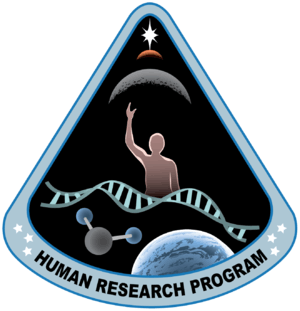Human Research Program
The Human Research Program (HRP) was created in October 2005 at Johnson Space Center (JSC) in response to NASA's desire to move human research project management away from headquarters to JSC and to focus its research investment on investigating and mitigating the highest risks to astronaut health and performance in support of exploration missions.[1] The HRP is an applied research and technology program that investigates and mitigates risks to astronaut health and performance in support of exploration missions and provides countermeasures and technologies for human space exploration.

Goals
The goal of the HRP is to provide human health and performance countermeasures, knowledge, technologies and tools to enable safe, reliable and productive human space exploration.[2] The Human Research Program also aims to educate the public on the challenges of human space flight.[3]
Human Research Roadmap
The Human Research Roadmap (HRR) is a web-based tool that is used to communicate the content of the Integrated Research Plan (IRP). The IRP is utilized to identify the approach and research activities planned to address risks to human health and performance in space which are assigned to specific Elements within the program.[2]
With this tool, users can search for items as gaps associated with a risk, the tasks associated with a given gap, the cross-integration of a task across multiple gaps or risks and deliverables associated with a gap or risk.[2]
Evidence
Reviews of the accumulated evidence from medical records, space flight operations and research findings are compiled into Evidence Reports. This evidence provides the basis for identifying the highest priority human risks in space exploration, which comprise the risk portfolio within the HRP. It also provides the basis for identifying gaps and tasks in the research plan.[2]
Risks
Risks include physiological effects of radiation, low gravity, terrestrial environments as well as unique challenges in medical support, human factors and behavioral health support. Risks are identified in the Program Requirements Document (PRD) and assigned to an Element within HRP to quantify, mitigate or monitor.[2]
A current list of risks being evaluated can be found at the Human Health and Performance in Space portal as well as at the HRR website.
Gaps
For each risk, the HRP Element identifies gaps in knowledge about the risk and the ability to mitigate the risk. The degree of uncertainty in understanding the likelihood, consequence and/or time-frame of a particular risk are the major factors that drive the gaps. Knowledge or mitigation gaps often appear in multiple risks, and many of the specific research tasks address multiple gaps.[2]
Tasks
Tasks partially or completely close a gap by better defining a risk or developing mitigation strategies to reduce the risk to an acceptable level. In some cases, a task can address multiple gaps across multiple risks.[2]
Deliverables
Each task culminates in a deliverable or other agreed upon end-product such as recommended standards, flight rules, processes, countermeasures and new technology.[2]
Elements
There are currently seven elements in the HRP.[4]
Analog experiments
The following experiments serve as Earth-based (terrestrial) analogs for the space flight environment.[4]
- Antarctica
- Bed Rest Studies
- Desert Research and Technology Studies (D-RATS)
- Haughton Mars Project - Research Station
- NASA Extreme Environment Mission Operations (NEEMO)
- Human-Related Altitude Chamber Complex
References
- "Human Research Program". Retrieved 8 August 2012.
- "Human Research Roadmap Architecture".
- "About Human Health and Safety". Retrieved 8 August 2012.
- "Human Research". Retrieved 8 August 2012.
External links
- Human Research Roadmap website
- Human Research Project website
- The Life Science Data Archive (LSDA) contains research data from NASA sponsored research.
- The Lifetime Surveillance of Astronaut Health (LSAH) is a repository of electronic health records of all astronauts and mission data which is collected according to the requirements set forth in the Medical Requirements Integration Document (MRID).